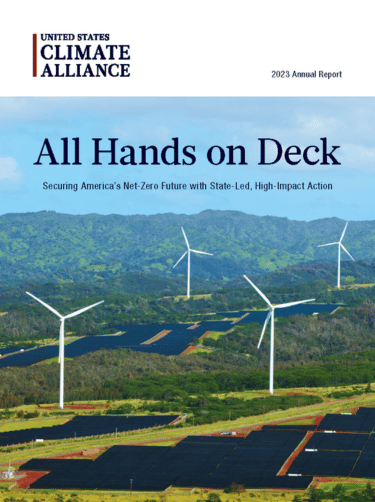Home / 2023 Annual Report | All Hands On Deck

This year, we’ve seen it all: unprecedented firestorms and wildfire smoke, extreme heat and drought, severe wind and hail, and catastrophic flooding. No state, no community has been spared. The unthinkable is swiftly becoming our new normal. The climate crisis is here — and this is America’s all-hands-on-deck moment.
Fortunately, from coast to coast, the U.S. Climate Alliance and our 25 governors are answering the call. As detailed in the 2023 Annual Report, after more than six years since we launched, our resolve and our commitment have never been stronger. And most importantly, our climate actions have never been more bold or impactful.
See below for highlights from 2023, and read the Annual Report for the full update on our progress.
In addition to growing and diversifying membership, in 2023 Alliance members advanced and accelerated new policies, programs, and investments across sectors, set net-zero targets, developed economy-wide cap-and-invest programs, and tackled climate pollution from harder-to-decarbonize sectors, like buildings and industry.
As the global community comes together this year to take stock of its progress in fulfilling the goals of the Paris Agreement, the Alliance is doing the same.
The Alliance reduced its collective net greenhouse gas (GHG) emissions by 18% between 2005 and 2021, and is now on track to meet its near-term climate goal by reducing collective GHG emissions 26% below 2005 levels by 2025.
In addition to decreasing net emissions, at the same time the economies in Alliance states and territories grew by nearly 30%, and governors acted to improve public health, create jobs, and protect communities.
Compared to the rest of the country, Alliance members in 2023 continued to:
New, independent analysis shows that by working with one another — and in coordination with the federal government — there is a clear pathway for Alliance members to meet their collective goals of reducing net GHG emissions at least 50-52 percent by 2030 and achieving overall net-zero GHG emissions by 2050, both below 2005 levels.
Alliance members are working together to advance a series of bold, high-impact actions across 10 key policy areas — GHG targets and governance; buildings; climate finance; electricity generation; industry; just transition and equity; natural and working lands; pricing carbon and valuing damages; resilience; and transportation.
These state-led climate efforts are being deployed at scale in each policy area to cut GHG emissions, safeguard public health, grow the economy, and build climate resilience.
Transforming historic federal investments, including from the Inflation Reduction Act (IRA), into meaningful action is an all-hands-on-deck effort. Additional action is needed using the federal government’s executive and regulatory powers to put our nation on path to meet U.S. emissions reduction targets.
Throughout the year, the Alliance has continued to partner closely with the Biden administration to support continued prompt, effective deployment of federal executive authority across more than 20 specific recommendations laid out by the Alliance for federal climate action.
Achieving collective climate goals means ensuring all workers and families are better protected from the worsening impacts of climate crisis, making communities more resilient to future extreme weather events expected under current warming conditions, and delivering more public health and economic benefits beyond what Alliance members have already achieved.
While current progress is encouraging, more action is urgently needed across all sectors of the economy to make these goals a reality. With this in mind, and with renewed resolve and focus, Alliance members will continue working with one another and the federal government to take the next generation of actions to ensure a safe and healthy planet for all.